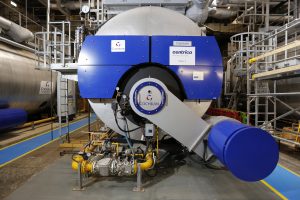Louis Burford, head of solution sales and optimisation at Centrica Business Solutions, explores the importance of distributed energy technology for developers and planners
Pressure is mounting on businesses to reduce their carbon emissions and operate more sustainably. The government’s Clean Growth Strategy, which aims to decarbonise the UK economy, sets targets for businesses to reduce their emissions. Those expectations are likely to increase further now that a 2050 deadline for the UK to be carbon-neutral has been set.
At the same time, consumers increasingly prefer to buy from greener companies, applying competitive pressure on firms to implement ever more sustainable practices.
Businesses are responding to these demands. In a recent survey, we found that 44% of companies consider the environmental impact of most business decisions and 40% plan to significantly reduce or eliminate their carbon footprint.
Some are adopting new measures to reduce their environmental footprint, such as installing energy efficient lighting (28%) or making improvements to the fabric of buildings (22%). This trend looks set to continue, too, as almost half (46%) of firms said that being socially and environmentally responsible was one of their top business priorities over the next three years.
This focus on environmental sustainability presents a new opportunity for the construction industry, developers and planners who are responsible for creating the built environment. Designing and engineering sustainable buildings with low-environmental impacts can now be a real point of difference when bidding for new contracts.
While some have long been using materials that help improve the energy efficiency of buildings in their projects, now is the time for many to start going further and considering how distributed energy technology can be factored into the design of a new building and what benefits it will bring.
What is distributed energy technology?
Traditionally, large-scale energy generation takes place at centralised facilities such as power plants before being fed into a large distribution network. The shift towards a decentralised energy system means that energy is increasingly being generated off the main grid, closer to where it will be used.
Distributed energy technology allows businesses to both generate and storage their own energy. Technology such as combined heat and power units (CHP), solar panels and industrial batteries can help reduce the environmental impact of buildings and the businesses that operate within them.

Our research found that if just half of organisations within key sectors including healthcare, industry and hospitality adopted distributed energy technologies, it would reduce the UK’s emissions by 137 MtCO2e – equivalent to taking nearly 30 million cars off the road in a year, and a step on the road towards the government’s Net Zero ambitions.
Distributed energy technology can also offer businesses significant commercial benefits. Not only can it be a source of revenue for firms that sell excess energy produced on-site back to the grid, it can also improve businesses’ reputations, as well as reducing reliance on the grid for power.
Making it work on your projects
There are a variety of different systems that can be installed, giving all those working in the built environment the flexibility often needed in design and planning.
For example, CHPs and battery storage systems are available in multiple different sizes, which is particularly useful to those working primarily on retrofitting buildings as they can help to accommodate the space you have to work in.
We recently completed a project with Manchester University NHS Foundation Trust (MFT), which invested in state-of-the-art energy technology at two hospitals to replace energy infrastructure that was nearing the end of its life. At one site we created a dedicated energy centre containing a 2 MWe CHP and four high-efficiency boilers, while at the other, where space was more limited, we installed a smaller 100 kWe CHP unit. The measures have already reduced annual emissions across the Trust by 25% – the equivalent of taking more than 780 cars off the road.
For those projects that are just getting off the ground, planners have the freedom to bake extra space into the design for new energy technology, and for larger projects consider the creation of dedicated energy spaces like energy centres.
Even if you’re not ready to install distributed energy technology yet, there are tools you can use as you start on your energy journey. For example, energy insights technology like Panoramic Power can help you to build up an understanding of your current energy use and demands.
Panoramic Power is a system of wireless sensors that connect energy-using equipment to a distribution board. The insight from the sensors can help firms to monitor energy use and identify any fluctuations that could indicate faulty equipment or inefficient practices.
Unlocking the benefits
Harnessing the benefits of distributed energy technology presents a real opportunity for the sector. Whether it’s setting firms apart from the competition or realising cost benefits from better energy management, the role of energy technology goes far beyond being just keeping the lights on and the buildings warm.
 Louis Burford
Louis Burford
Head of solution sales and optimisation
www.centricabusinesssolutions.com
LinkedIn: Centrica Business Solutions UK & Ireland













